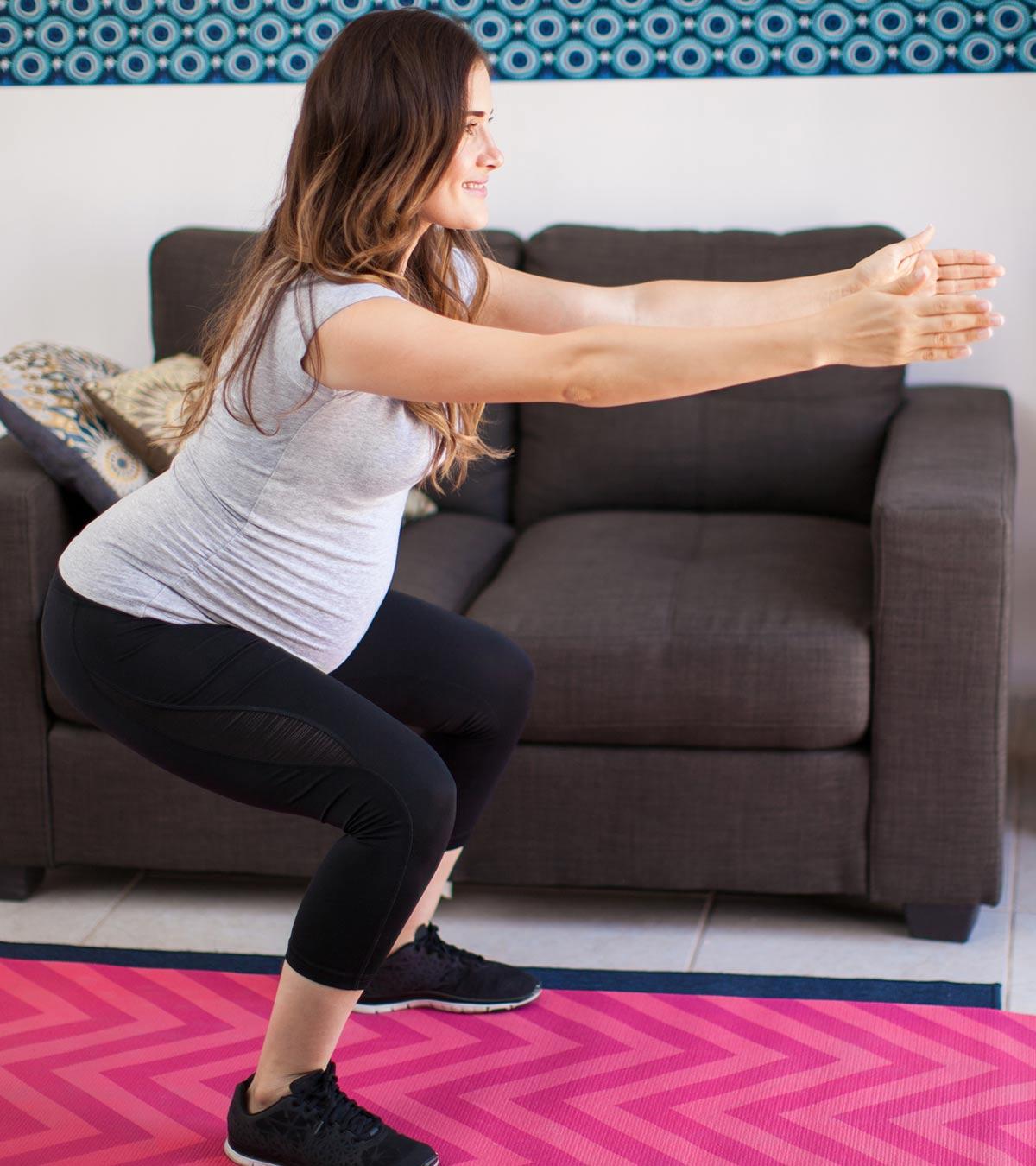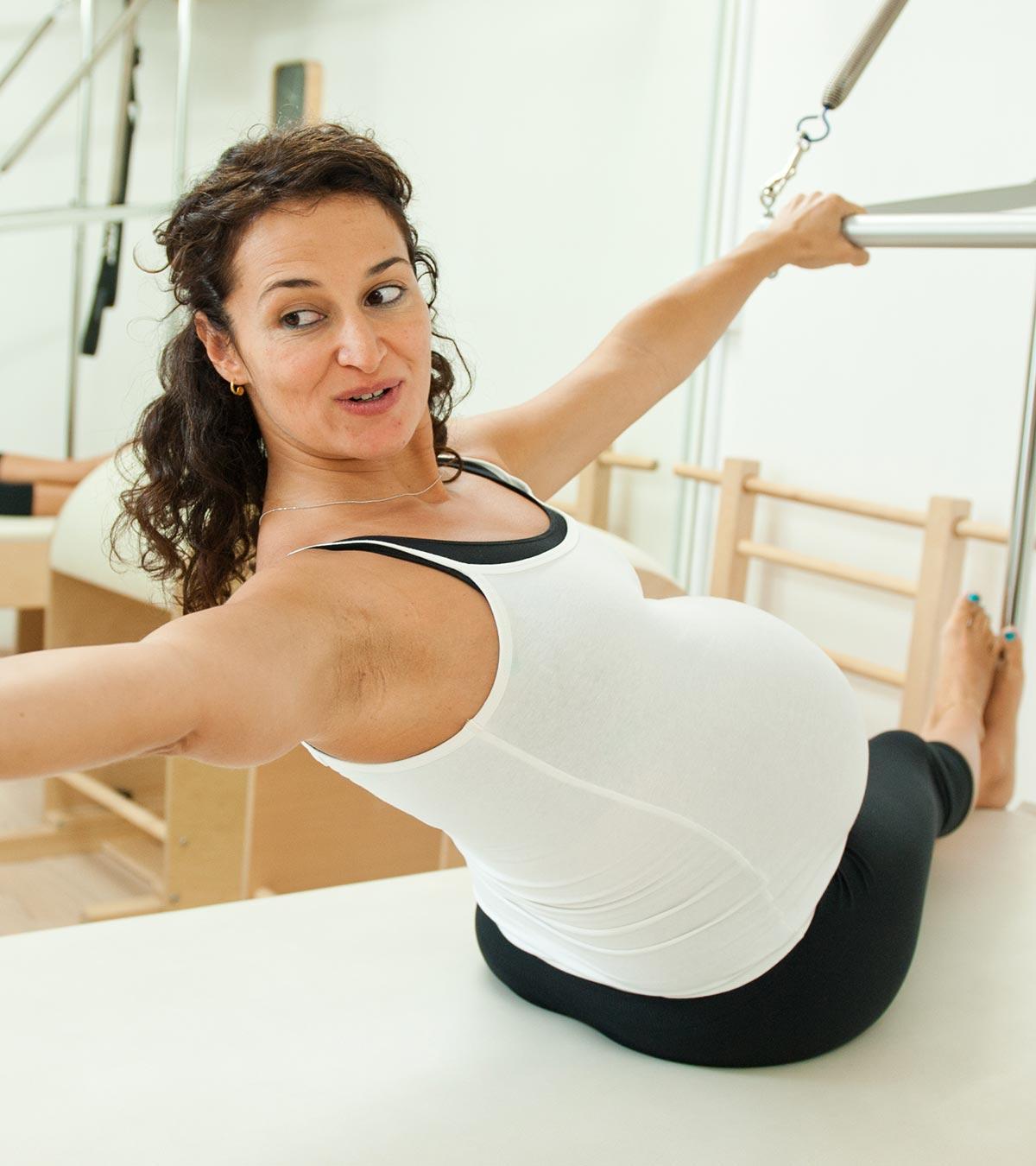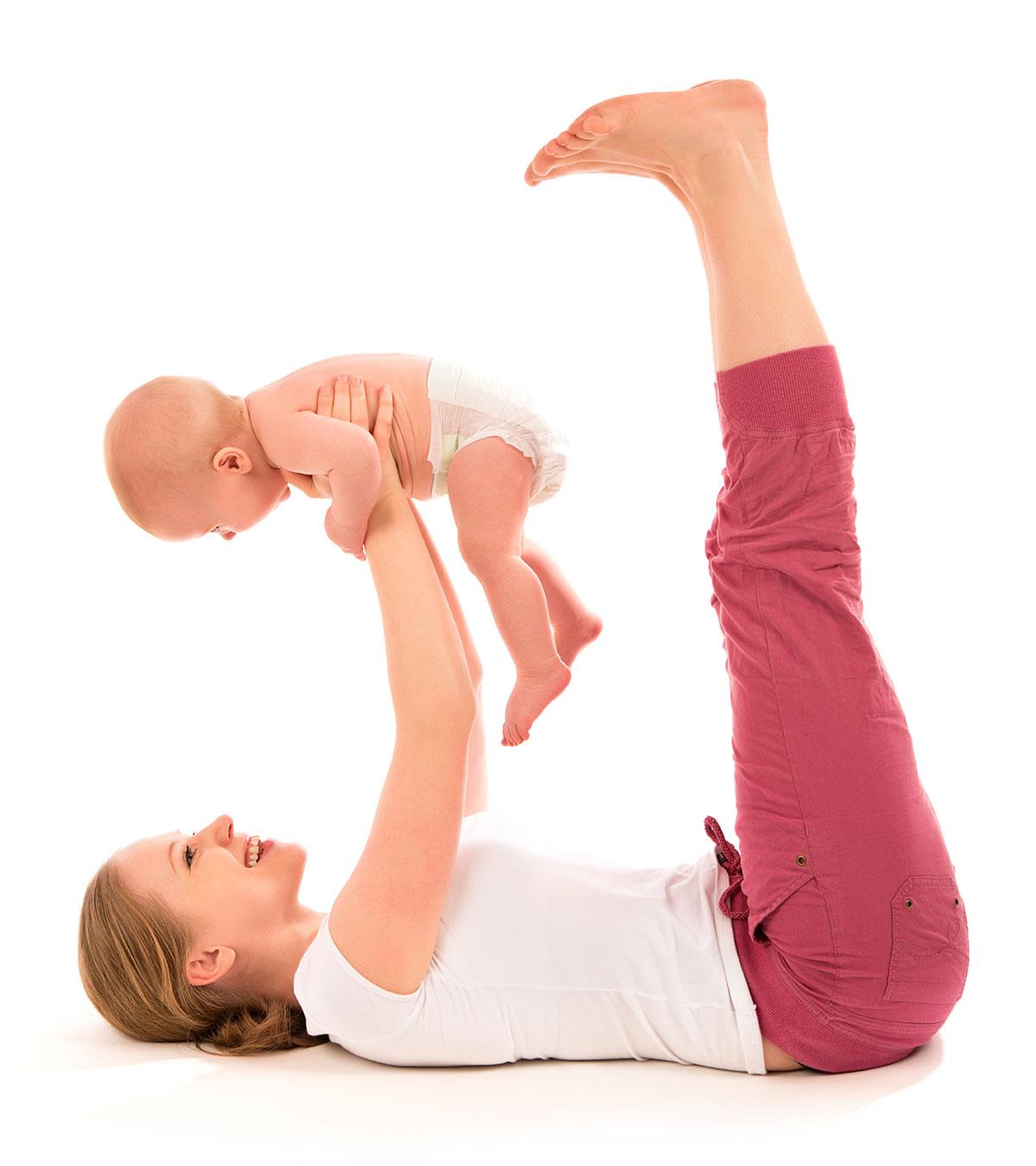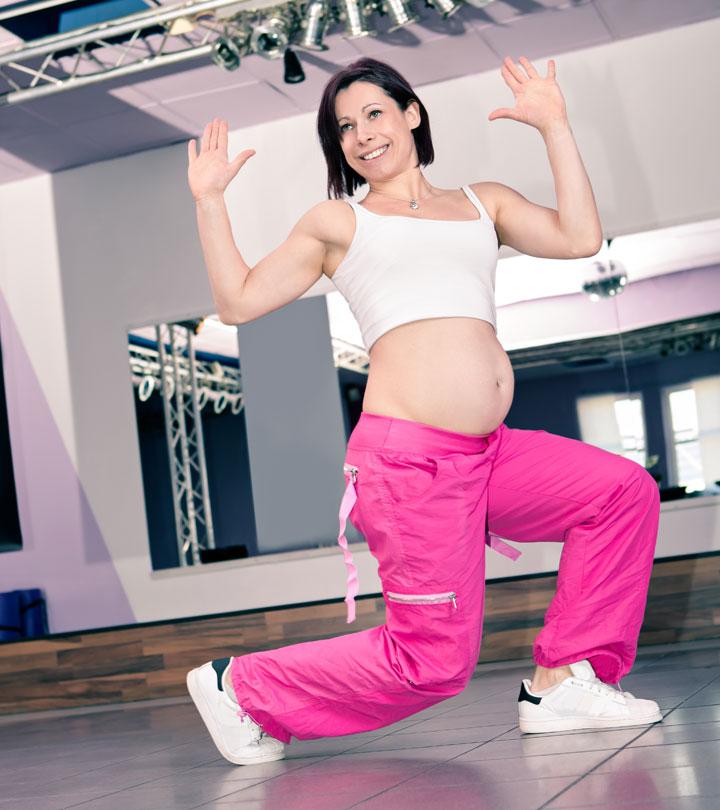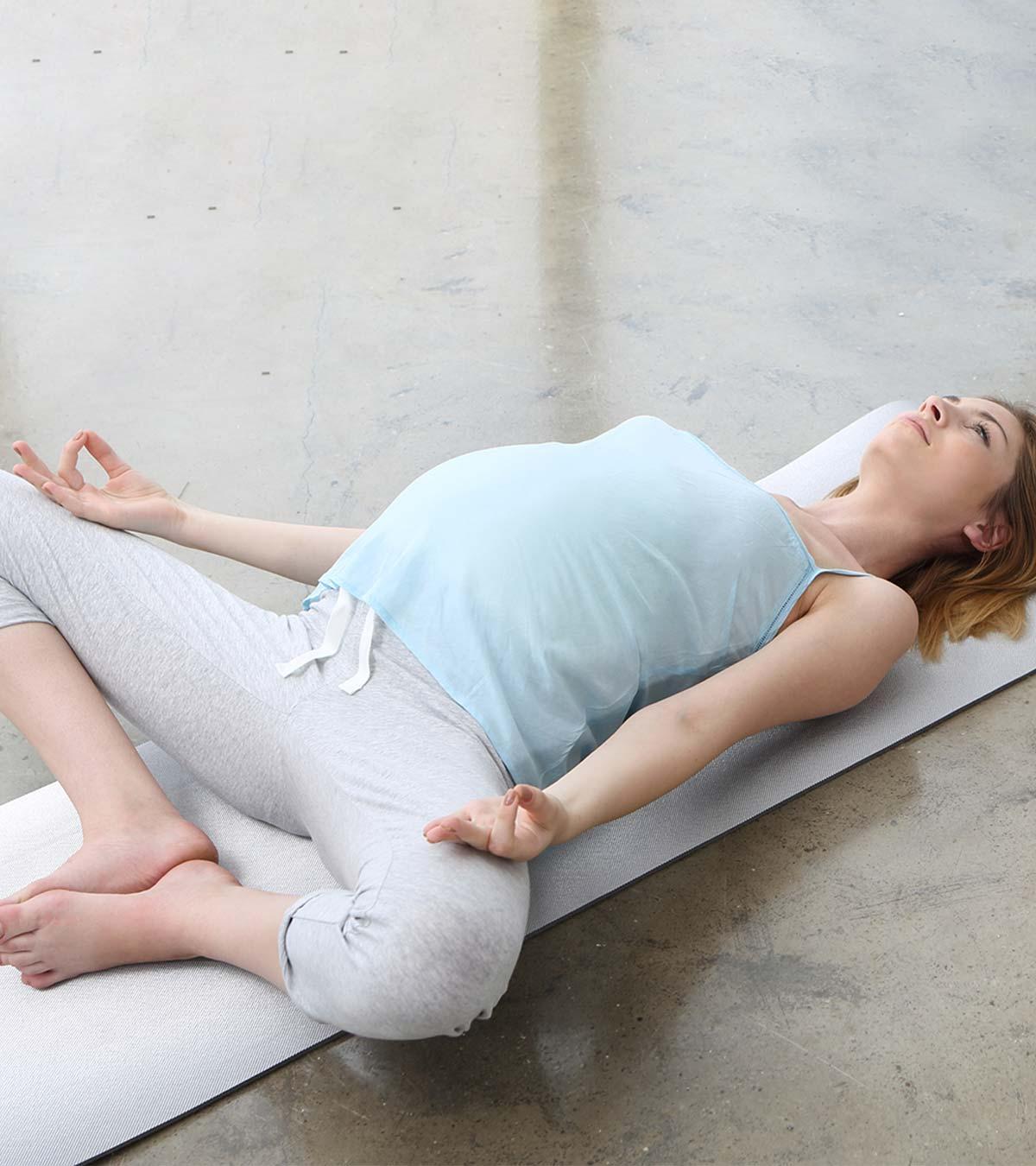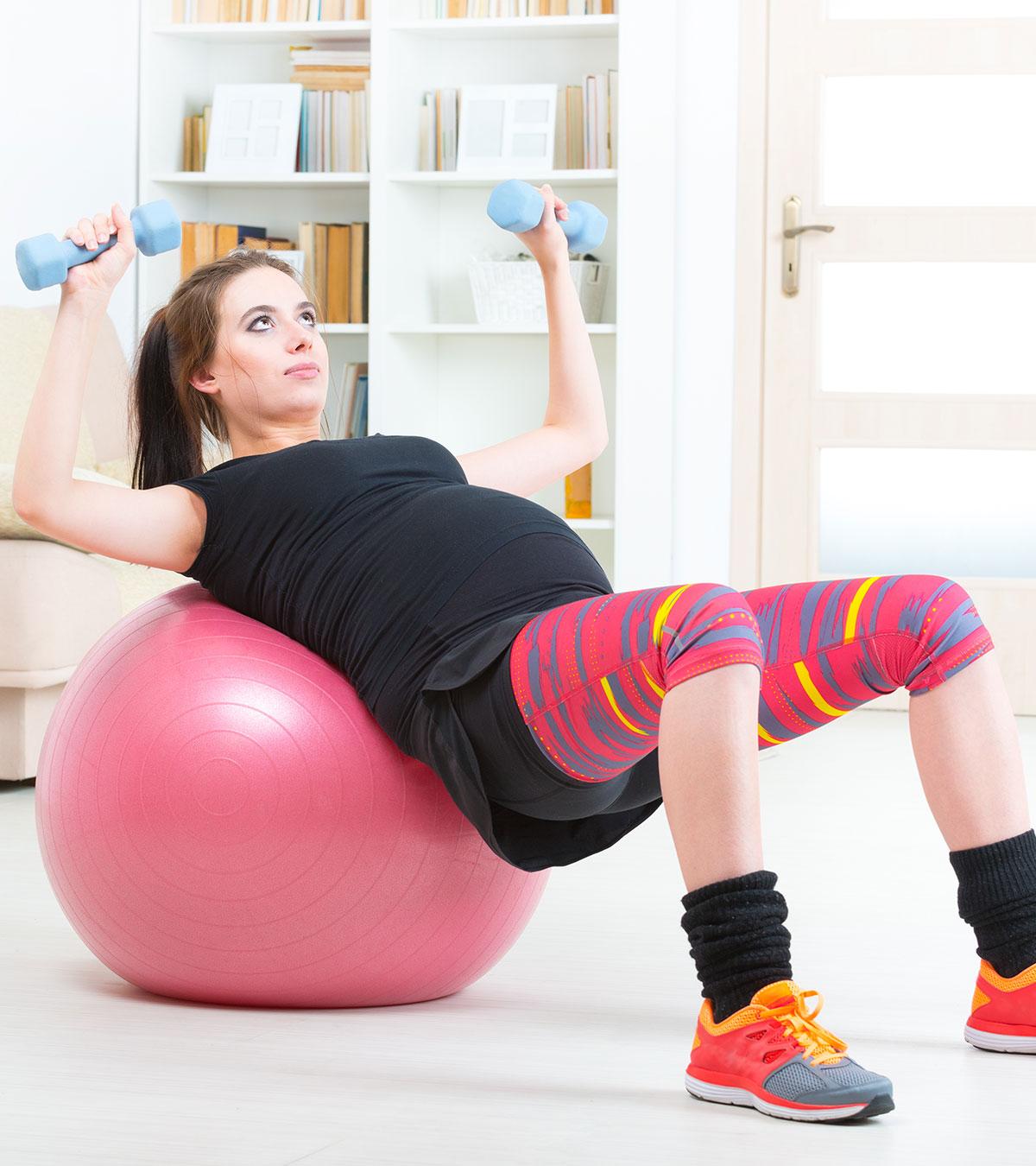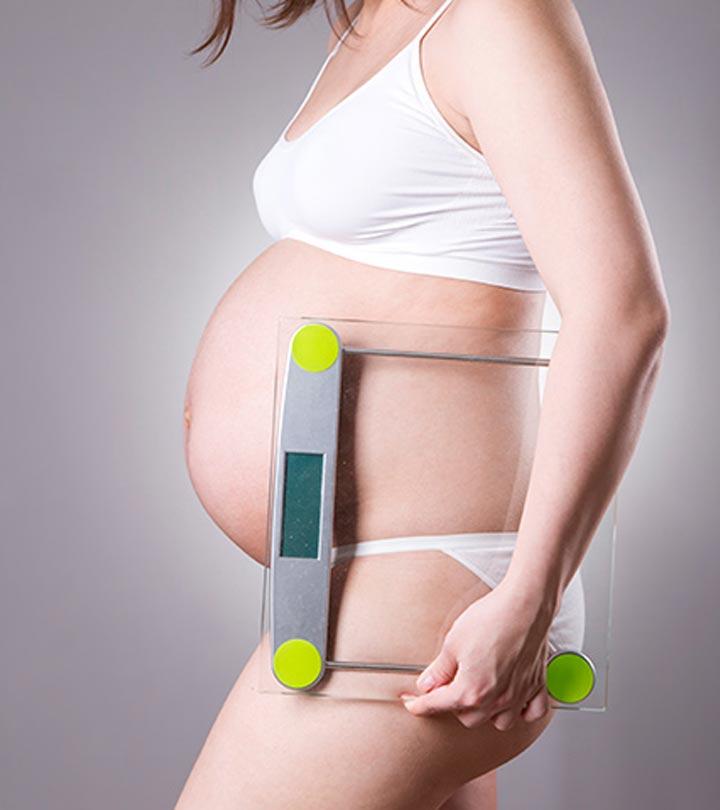
Image: ShutterStock
If you enjoyed ab exercises before conception and have been missing them, here’s more about abdominal exercises during pregnancy. Most women may skip their exercise regimen once they conceive, thinking it may affect fetal growth and development. However, the right exercises are beneficial for maternal and fetal health. They can tone your body, strengthen your muscles, and prepare you for delivery. Abdominal exercises also fall under this category. When a pregnant mother performs guided ab exercises, these light yet powerful movements may reduce backache and make delivery easier. Keep reading as we discuss more on ab exercise in pregnancy. However, you may consult your doctor and practice these exercises under their supervision for a healthy pregnancy.
Key Pointers
- Safe and modified abdominal exercises during pregnancy can improve core strength, stability, and posture.
- Regular exercise during pregnancy can reduce stress, promote overall health, and aid in a faster recovery after delivery.
- It’s important to get approval from your doctor before attempting any exercise during pregnancy.
- Some safe abdominal exercises include pelvic tilt, pelvic rock, and modified planks.
- Strengthening core muscles can also be achieved through deep breathing and Kegel exercises.
Best Abdominal Exercises To Perform During Pregnancy
Caution: Do not work on any of these exercises without consulting your doctor.
According to the US Centers for Disease Control and Prevention (CDC), you may begin or continue moderate-intensity exercises during pregnancy unless there is a medical reason to avoid it (1).
During pregnancy, you must stay fit and follow your exercise routine for proper weight management. Here are some abdominal exercises you can include in your prenatal care routine:
1. Sitting knee lift
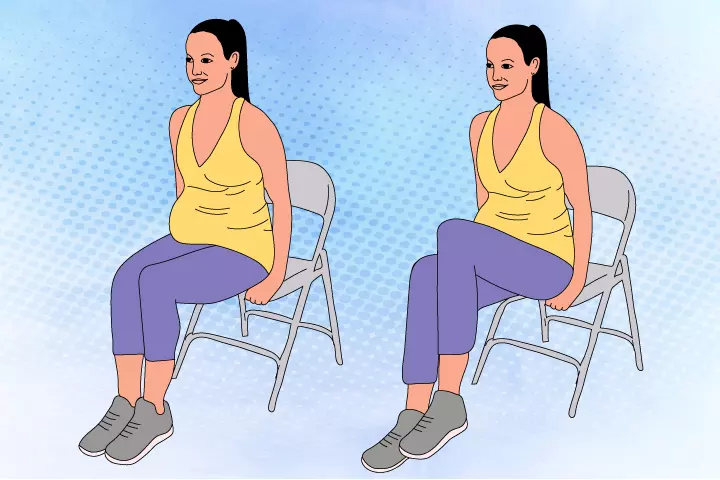
This exercise can be performed with the help of a chair. It helps strengthen your core muscles.
How to:
- Take a sturdy chair and sit down near the edge.
- Keep your feet flat on the floor directly under your knees.
- Keep your palms facing downward under your hips.
- Slowly contract your abdomen by bending your left knee in such a way that it tilts your pelvis.
- Now, slowly bring your bent knee towards your chest.
- Start lowering your left foot to the floor while coming back to your neutral position.
- Repeat all the above steps with your right leg.
In the first trimester, do two sets of 8 to 12 repetitions. You can also do it by attaching weights of 1 to 3lb on each ankle.
In the second and third trimesters, do up to two sets of 8 to 10 repetitions.
2. Side-lying crunch
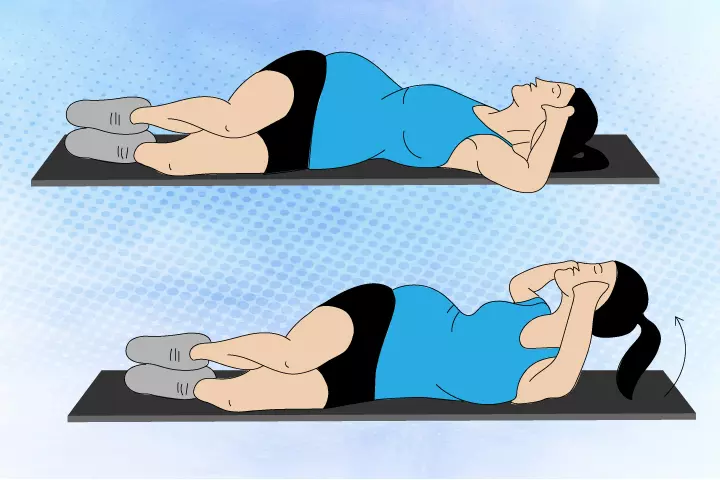
It is one of the safest abdominal pregnancy exercises.
How to do:
- Lie on the floor.
- Slowly roll your body to the left side and fold your knees at a 30o angle to your hips.
- Roll the body towards the right side so that your knees rise about 6in from the floor.
- Ensure that your body weight rests on the back of your left shoulder and the shoulder blade.
- Put both the hands behind your head with the fingertips touching.
- Curl your torso upwards in a diagonal position as if you are trying to touch your right knee. Raise it as much as you can.
- While doing the above steps, your left shoulder will rise a little from the floor.
- Bring your arms towards the knees and curl them a bit higher.
- Then place your hands behind the head and lower yourself to your original position.
- Repeat the steps on the other side.
Perform one set of six repetitions on both the sides. Once you feel comfortable, you can perform around 12 repetitions.
3. Core breath
This is one of the simpler abdominal exercises.
How to do:
- Sit down comfortably keeping your back straight.
- Position both your hands on your waist.
- Take a deep breath and open your ribs outward.
- Exhale the air gradually bringing your ribs back to one closing position.
- Relax your muscles by contracting the front of your pelvis and the tailbone.
- Repeat all the steps.
4. Seated ball stability hold
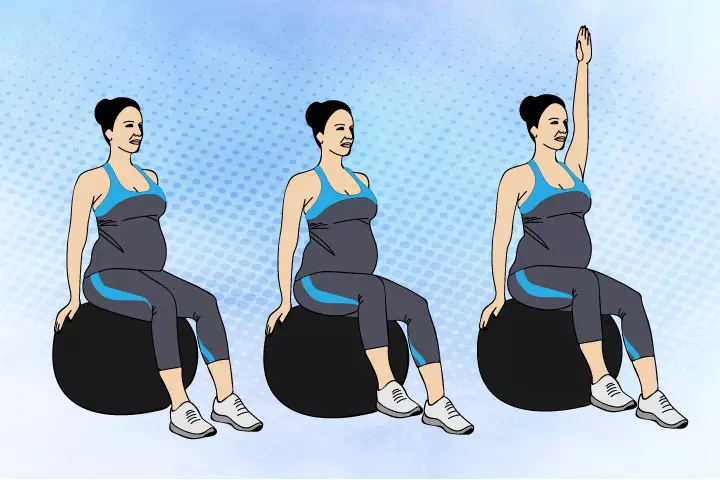
For this abdominal workout, you need a stability ball. Take help from your partner or friend to help you balance while sitting on the ball if you have never tried it before.
How to do:
- Sit on a stability ball with your posture straight and the back erect.
- Put your hands on the sides to maintain the balance.
- Inhale from the core while lifting your foot off the ground and raising the opposite arm up over your head.
- Hold your breath for two to three seconds and return to the initial position.
- Repeat with the other arm and foot.
5. Side plank
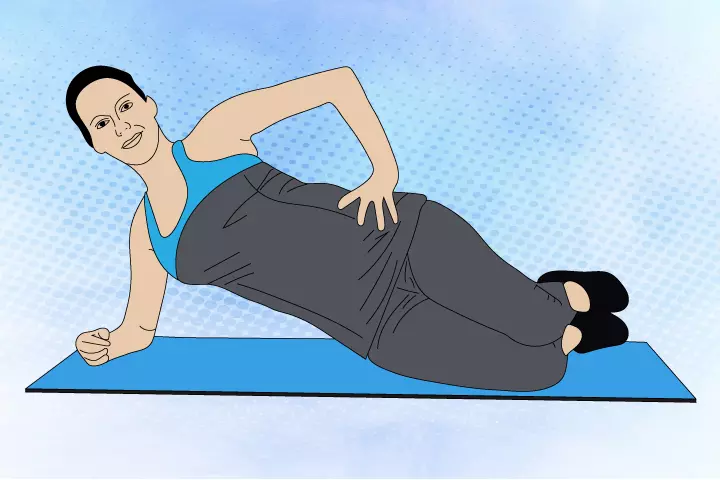
Side plank is done in several ways. Here is the one safe abdominal exercise during pregnancy.
How to do:
- Lie down on your side.
- Place your elbow directly under the shoulder.
- Bend the knees and stack them on top of one another.
- Keep your spine neutral at this time and concentrate on your core breathing.
- Squeeze your hips and raise your torso to make it a straight line from head to hips.
- Keep your head and neck straight.
- You can hold the position for 20 to 30 seconds and keep breathing normally.
- Repeat the steps on the other side.
Side planks can be beneficial to maintain a proper physique during pregnancy. Michele, a fitness enthusiast and a mom of two opines, “Side planks help me feel super strong. You’re working the arm and shoulder and all of your stomach muscles. And I won’t lie (though maybe I should), from a vanity standpoint, I love that side planks help me keep a visual of my obliques throughout pregnancy. 9 months pregnant, 25 pounds up, and sporting some peek-a-boo abs? Oh yeah! I have worked so hard for that and I think it’s fair to be proud (i).”
6. The standing crunch
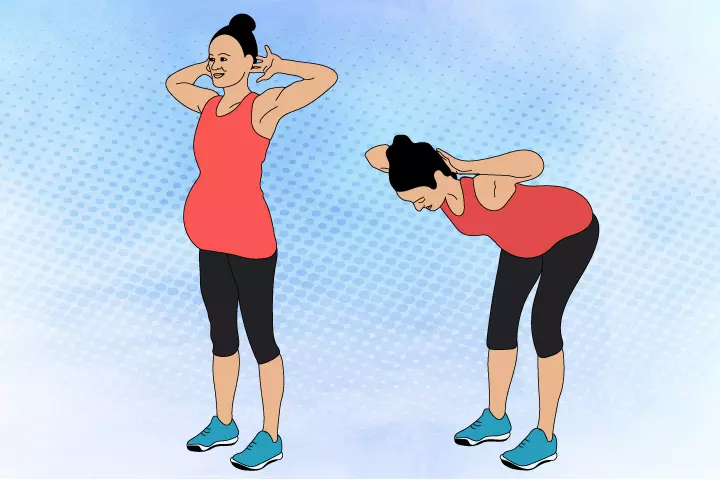
This is similar to the crunch you do while lying down.
How to do:
- Stand straight and place your feet at hip length.
- Keep your knees slightly bent, and place your hands behind your head.
- Pull your belly button in and tuck your pelvis.
- Slowly crunch forward, squeezing your abdominal muscles just the way you do it while lying on your back.
- Do around 15 to 20 repetitions.
7. The standing bicycle
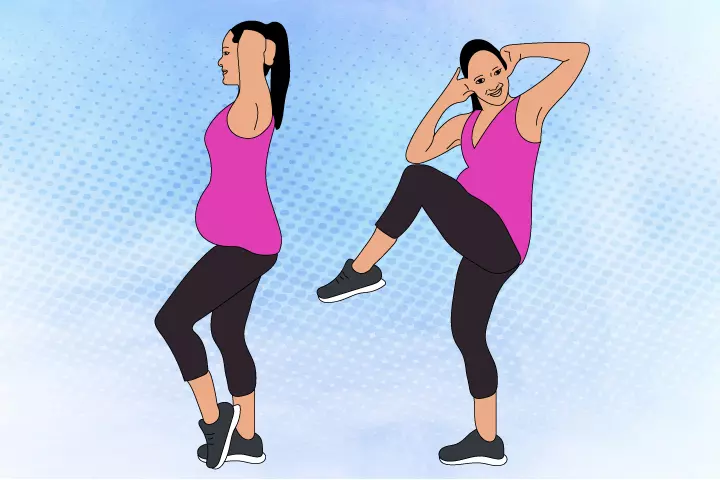
It is an excellent exercise to improve your balance and enhance your core strength. Unlike other exercises that are done on the floor, it reduces any risks of hurting your lower back.
How to do:
- Keep your feet as wide as your hips
- Crunch forward
- Lift your right knee towards your chest
- Twist toward the right side such that your left elbow touches your right knee
- Go back to the original standing position and repeat it with your left foot and right elbow.
- Repeat these steps for at least 10 to 20 times
8. Standing toe touches
It helps relieve the strain on your lower back and increase the flexibility of your spine and hips.
How to do:
- Stand straight, placing your feet as wide as your hips.
- Gently pull your belly button inwards and tuck your pelvis under you.
- Raise both your arms upwards, placing them right straight above your head.
- Slowly bend forward bringing down your arms together.
- Try to touch your toes or bend as much as possible without putting much pressure on your abdomen.
- Repeat it 10 to 12 times.
9. Kegels
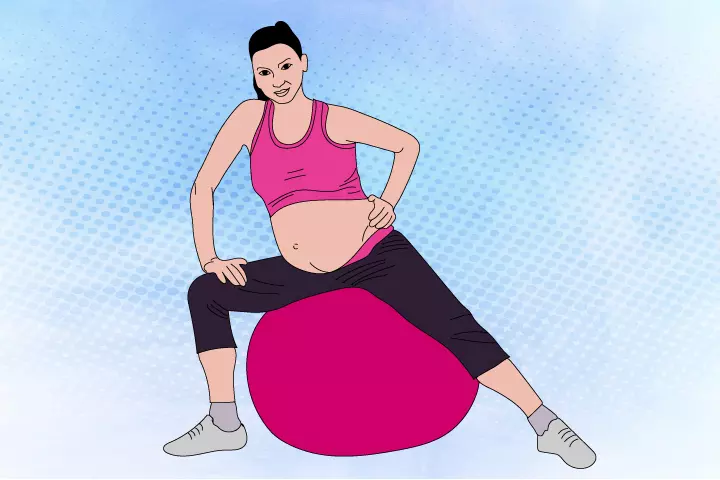
- Sit down comfortably on the exercise ball and inhale nice and full. While you are breathing in, let your belly rise as the air fills in. Once you have inhaled enough, slowly exhale to let all the air out.
- Make sure to match your inhalation length to that of your exhalation length.
- The next time when you exhale, try to tighten your vaginal muscles. It should resemble the tightening of muscles when you badly need to pee but are forced to hold.
- Relax your neck, face, and shoulders. At this point, only the muscles of your pelvic floor should feel tight and contracted. Hold the pose to the count of five to eight and then slowly release.
- Try to do it at least 20 times per day, and aim to increase the count gradually.
10. Squat

It is the good ab exercise, to help you assist with the pushing stage during delivery.
How to do:
- Stand straight and keep your feet as wide as your hips.
- Raise your arms straight in front of your chest.
- Slowly squat down. If you feel uncomfortable or out of balance, then ask your partner or a friend to hold you so that you can regain your balance. After you try it for a few times, you will slowly get comfortable doing this workout.
- Make sure that you press your heels into the floor while performing this squat.
- Slowly squat as much as you can towards the floor.
- While squatting, keep the shoulders, back and abs controlled in such a way the pressure can be felt at these points.
- Now, slowly get back to your neutral position. Try doing two sets of 15 repetitions each.
Once you enter the second trimester, you might find it difficult to squat. You can continue doing the exercise by squatting as much as you can. However, it is advisable to have your partner or someone to support you during this exercise.
11. Cat cow pose
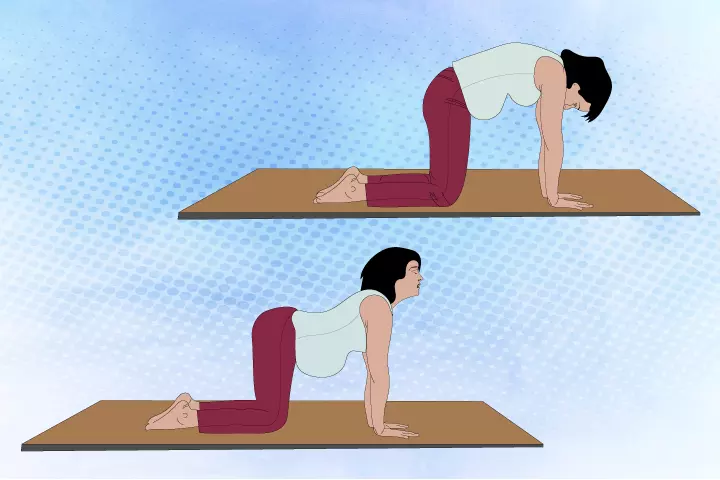
It helps strengthen the core muscles and increases the flexibility of your back and spine.
How to do:
- Get down on the floor on your hands and legs.
- Position your hands directly under your shoulders and your knees under your hips.
- Start inhaling and look upwards towards the roof. While doing this, arch your back.
- While you exhale, tuck in your chin and your tailbone, and pull your belly button inward towards your spine.
- Keep doing the inhaling and exhaling exercise in such a way that you can match your breathing rhythm to your movements as much as you can.
- Repeat the steps for two minutes, take a break and resume. It is one of the safe ab exercises while pregnant.
13. Side-lying leg lifts
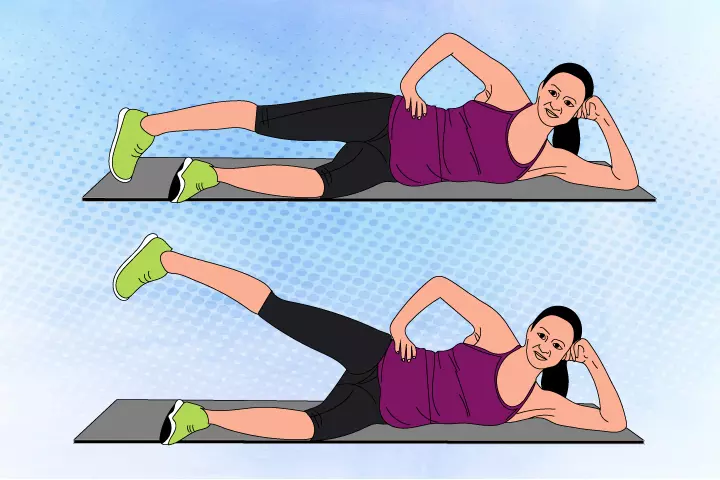
It helps strengthen your glute and hip muscles.
How to do:
- Lie down on your left side with your legs stacked one on the other. Keep your left elbow on the ground so that it can support your upper body.
- Now lift your right leg slowly. Lift it as high up as you can. Make sure that your hips are in a straight line with your body.
- Bring your leg down to about two inches above your left leg.
- Do about 20 repetitions with each leg and keep doing it until your legs start to feel tired.
14. Bird dog

It is a stability exercise that strengthens your abs.
How to do:
- Get down on the floor on your knees. Before you begin, place your wrists directly under your shoulders and knees under your hips.
- Keep your back straight.
- Keep the muscles around your abdomen tight.
- Now, slowly lift your left leg and extend it in a straight line behind you. The muscles around your abdomen area should be tight.
- While doing this step, lift up your right arm and then bring it straight in front of you.
- Pause for a while and hold the step.
- Slowly start breathing as you release your pose and return to the neutral position.
- Repeat the same steps with your opposite hand and leg.
15. Standing pelvic tilt
It is a good exercise to help improve your posture and to strengthen your back and abdominal muscles.
How to do:
- Stand straight near a wall.
- Place your back and hips against the wall.
- Your heels should be 12 to 18 inches away from the wall. You will notice a small space between the wall and your lower back.
- Now, start flexing in your abs till you feel the pressure and your hips start tilting backward. You will feel your lower back flattening itself against the wall.
- Hold this pose for five seconds and release.
- Repeat it ten times.
16. Hip hiker
It helps strengthen the glute and hip muscles.
How to do:
- Lie down comfortably on your side.
- Bend your bottom leg while keeping your top leg straight. If you feel uncomfortable, make use of a pillow to support your head.
- Now raise your top leg about 2 to 4 inches from the ground.
- Keep your leg straight. Use the muscles on the side of your abdomen to pull your hip.
- Hold the position for about five seconds.
- Repeat the steps ten times.
Repeat it with the other leg.
17. No crunch crunches
It is an excellent exercise to strengthen the abdominal muscles.
How to do:
- Lie down on your back comfortably.
- Bend your knees and place your feet firm on the floor.
- Put your hands below and to the side of the belly button.
- Gently press two fingers of each hand into the lower abdomen.
- Now gradually push down on the lower abdomen. While doing this do not move the pelvis. Raise your chest upwards without holding your breath.
- As you feel the tightening of the abdominal muscles, you must stop working out immediately. You might feel the tightness of the muscles below your fingers.
- Hold the position for around 10 seconds and release.
- Carry out 20 repetitions.
18. Scissor kicks

Do this abs workout during the first trimester only. Even if you feel comfortable doing it in the subsequent trimesters, it is good to avoid it.
How to perform:
- Lie down on your back and place your hands flat under your hips.
- Keep your back as flat as possible on the floor.
- Slowly raise one of your legs about 10 inches up from the ground.
- Start lowering the raised leg while raising the other leg.
- Do three sets of ten scissor kicks. Take a little rest in between each set.
19. Heel slides
It helps stretch the muscles in your thighs.
How to do:
- Lie on the back comfortably with your arms along the sides.
- Bend your knees and bring the feet inside towards the butt.
- Lifting your heel a little above the ground, extend one leg at a time.
- Slowly come to your original position.
- Repeat the steps by lifting the other leg.
20. Single heel drop
This exercise helps strengthen the glute muscles.
How to do:
- Lie on the back with your arms along the sides.
- Bend the knees to 90 degrees.
- Straighten one leg while keeping the other at 90 degrees.
- Tighten your abs and lower the straightened leg.
- Touch the ground before folding it back.
- Repeat the step with the other leg.
21. Engaging your TA
It is an excellent abdominal exercise while pregnant for strengthening your core muscles and is safe for diastasis recti
.
How to do:
- Sit straight and take a deep breath.
- Place your hand on your belly button.
- Inhale deeply till you feel your belly button and lower rib cage expanding, without raising your shoulders.
- Now exhale pulling your belly button towards inside while contracting your TA.
- Perform 5-10 repetitions by controlling your breath.
22. Leg Raises
Leg raises are an effective exercise for fortifying your back and abdominal muscles.
How to do:
- Start on all fours, hands under shoulders.
- Keep arms straight and fully extend them.
- Lift your right knee off the floor, extending it straight back.
- Aim for a parallel position with the floor for your raised right leg.
- Gently lower your right knee back to the floor.
- Lift your left knee, extending the leg straight back to parallel the floor.
- Carefully lower your left knee back to the starting position.
- Gradually intensify by repeating the sequence on both sides.
- Work towards completing up to 10 repetitions on each side.
You must consult your doctor before beginning with any exercise regime as they can advise you on the exercises to do depending on your overall health condition.
How Are Abdominal Exercises Helpful During Pregnancy?
According to Ohio-based certified prenatal fitness specialist Nicole Scheitlin, “Having a strong core is crucial during pregnancy, and it involves training your deeper abdominal muscles (transverse abdominis) and pelvic floor. This approach enhances balance and stability while alleviating discomfort associated with weak abdominal muscles, such as back pain, sciatica, and pelvic pain. However, selecting safe exercises focusing on the abdominals is important to avoid increasing the risk of greater abdominal separation (diastasis recti).”
Staying fit is a priority for every pregnant woman to help maintain proper maternal health. And the best way to achieve your fitness goals is by engaging in regular abdominal exercises because they (3):
- Make your body flexible
- Improve posture and offer relief from back pain
- Help prepare you for natural childbirth by toning your muscles in the abdomen
- Boost your energy and keep you active throughout the day
- Improve your ability to cope with labor
- Promote strength and endurance
- Strengthen your core muscles
But before beginning the abdominal exercise, you need to know some safety tips.
Safety Measures While Performing Abdominal Exercises When Pregnant
You may remember these points while doing the abdominal exercises or any form of maternity yoga:
- During the first trimester, you can exercise for a longer time by increasing the number of repetitions, as long as you are comfortable. You can also workout by adding a little weight to your ab exercises.
- In the second and third trimesters, reduce the intensity of your workout or stop doing a few exercises completely as they might hurt you.
- Do not do exercises in a supine position (lying on your back) after the first trimester (4).
- Do not do exercises that involve intense twisting motions or high-impact movements.
- Drink water and fresh juices and stay hydrated. Take sips in between the repetitions.
- Avoid exercising in hot and humid conditions as it could increase your body temperature, and also dehydrate you.
- Do not overdo the abdominal exercises. Stop doing the exercises if you feel an increase in your heartbeat or are exhausted.
- Avoid doing any exercises that involve abrupt movements.
- If you haven’t exercised earlier, and begin it during pregnancy, then start with just five minutes of exercise a day. Extend it by five minutes each week until you reach 30 minutes a day and under the supervision of a trainer (5).
According to the American College of Obstetricians and Gynecologists (ACOG), physical activity during pregnancy does not cause miscarriage or preterm delivery (6).
Also, before you begin working out, you need to check if you have diastasis recti – the separation of the two muscle bellies of rectus abdominis.
What Is Abdominal Separation Or Diastasis Recti?
Diastasis recti abdominis (DRA) is the separation of the two muscle bellies of rectus abdominis (7). During pregnancy, the growing belly stretches the abdominal muscles by pulling the rectus abdominis. The gap created between the left and right sides of the abdominal muscles widens as your baby grows. Women carrying twins or those who had multiple pregnancies are more likely to have this abdominal separation.
How To Check For Abdominal Separation Before Exercising?
You can know if you are having diastasis recti through these steps:
- Lie on your back and bend your knees.
- Keep the soles of your feet flat on the ground and a pillow under your head and shoulders.
- Let your arms rest along your sides with the palms facing down.
- Now raise your head slightly with your arms extended forward. If you feel a gap above and below the belly button then you might have an abdominal muscle separation. Check with your doctor to confirm it.
- If you have diastasis recti, check with your trainer on which exercises to do and which to avoid.
 Did you know?
Did you know?Frequently Asked Questions
1. How often can I do abdominal exercises during pregnancy?
It is recommended to engage in strength-building exercises for the abdominal muscles up to two times per week, with at least one day between each session (9).
2. Are there any risks associated with abdominal exercises during pregnancy?
Exercising in a supine position can cause the fetus to press against the mother’s blood vessels, which may reduce blood supply to the fetus or cause the mother to feel faint. Additionally, as the center of gravity shifts during pregnancy, there is an increased risk of falling while exercising. It is also important to avoid overstretching, as the ligaments become more relaxed during pregnancy and may lead to injury (9).
3. How can pregnant women modify their abdominal exercises to accommodate their growing belly?
Avoid lying flat on your back as it can compress the major blood vessel, potentially reducing blood flow to the baby. Instead, opt for exercises that involve supported reclined or side-lying positions. Focus on exercises that promote core stability and prioritize strengthening the pelvic floor muscles (10). Pay attention to your posture. Maintain a neutral spine and avoid pushing your belly forward. Avoid twisting or bending exercises to prevent strain on the abdominal muscles and minimize the risk of any discomfort or injury.
4. Can abdominal exercises help prevent diastasis recti during pregnancy?
While abdominal exercises alone cannot completely prevent diastasis recti, they can help maintain the strength and integrity of the abdominal muscles, reducing the risk and severity of midline separation. However, it is crucial to perform these exercises properly and avoid excessive strain on the abdomen (11). Consult a qualified prenatal exercise specialist or physical therapist for personalized guidance.
5. Can abdominal exercises help with postpartum recovery?
These exercises help maintain core strength, which is essential for regaining abdominal muscle tone and strength. Strong abdominal muscles contribute to core stability and promote good posture (12). Abdominal exercises focusing on transverse abdominis (deep abdominal muscles) can promote diastasis recti healing and hasten postpartum recovery.
6. How can pregnant women stay motivated to do abdominal exercises?
Setting realistic goals, exercising with a friend or partner, or enrolling in prenatal fitness classes or programs are ways expecting women can indulge in regular exercise. They may also consider joining a support group or talking to a certified prenatal fitness specialist to modify abdominal exercises as per their needs, which also helps them feel supported and motivated to do these exercises.
7. What signs indicate I should stop exercising during pregnancy?
Stop exercising and contact your doctor right away if you experience warning signs such as regular painful contractions, vaginal bleeding, shortness of breath (beyond your normal level), dizziness, or chest pain (13). Also, stop if you notice decreased fetal movement, fluid leaking from your vagina, or unusual weakness.
Regular abdominal exercise during pregnancy can make your body flexible, relieve back pain, and strengthen abdominal muscles to prepare you for natural childbirth. Side-ball crunch, seated ball stability hold, and bird dog are a few safe and effective abdominal exercises you can do after consulting your healthcare provider. Avoiding exercises that require abrupt movements, staying hydrated, and checking for diastasis recti before starting abdominal exercises are some simple safety measures you should follow to perform abdominal exercises during pregnancy safely.
Infographic: Precautions To Take While Performing Abdominal Exercises
Exercise during pregnancy can provide numerous benefits for you and your baby, but it’s essential to follow guidelines to ensure a safe and healthy experience. So, read the infographic below to learn some important safety measures to follow when performing abdominal exercises while pregnant. Illustration: Momjunction Design Team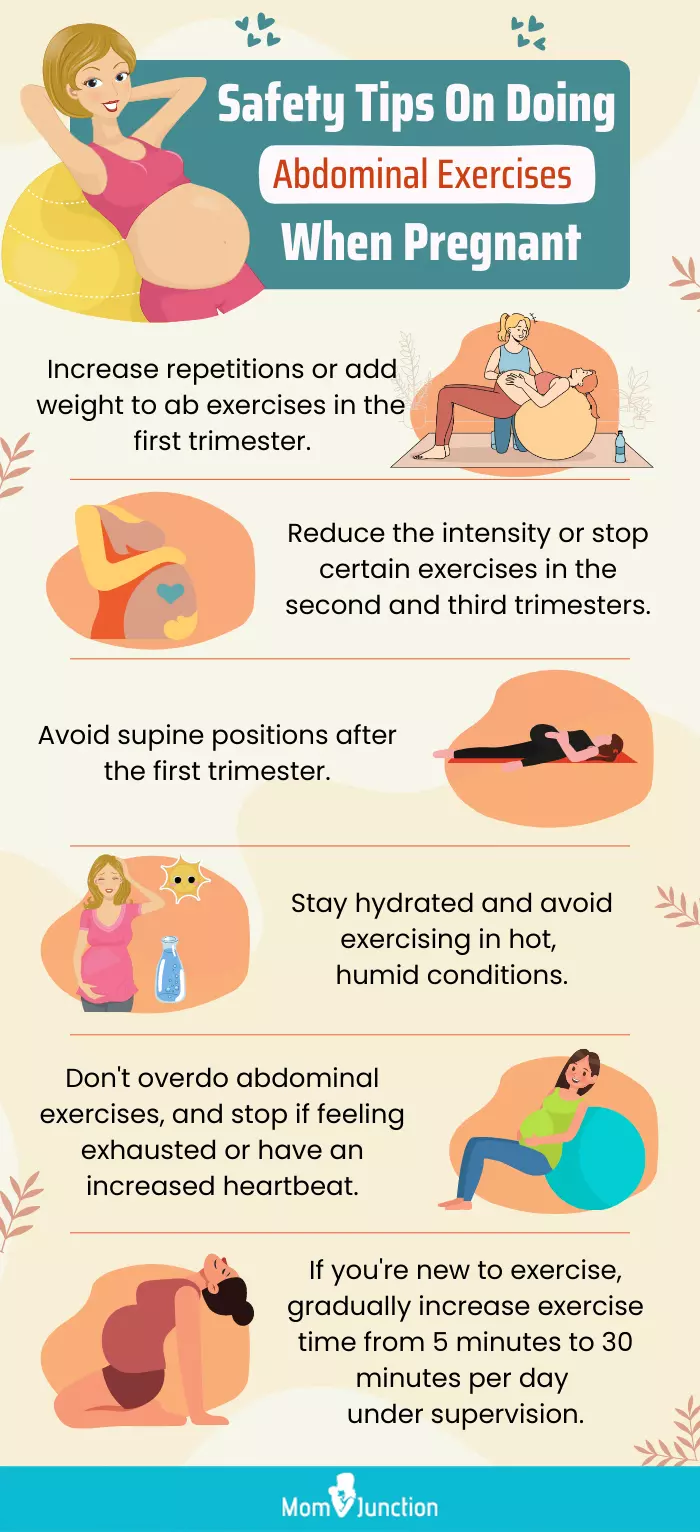
Illustration: Safe & Effective Abdominal (Ab) Exercises During Pregnancy
_exercises_during_pregnancy_illustration.jpg.webp)
Image: Stable Diffusion/MomJunction Design Team
Stay fit and healthy during pregnancy with abdominal exercises! Learn how to safely strengthen your core and prepare for childbirth.
Personal Experience: Source
MomJunction articles include first-hand experiences to provide you with better insights through real-life narratives. Here are the sources of personal accounts referenced in this article.
i. Peek-a-boo obliques (At 9 months pregnant);MomJunction articles include first-hand experiences to provide you with better insights through real-life narratives. Here are the sources of personal accounts referenced in this article.
https://fitnessbitesblogger.wordpress.com/2017/09/06/peek-a-boo-obliques-at-9-months-pregnant/References
- Physical Activity for Pregnant or Postpartum Women: An Overview
https://www.cdc.gov/physical-activity-basics/guidelines/healthy-pregnant-or-postpartum-women.html - Expert Care Throughout Your Pregnancy.
https://www.sutterhealth.org/cpmc/services/pregnancy-childbirth - Sally K. Hinman, et al; (2015); Exercise in Pregnancy.
https://www.ncbi.nlm.nih.gov/pmc/articles/PMC4622376/ - Kelly R. Evenson, et al; (2014); Guidelines for Physical Activity during Pregnancy: Comparisons From Around the World.
https://www.ncbi.nlm.nih.gov/pmc/articles/PMC4206837/ - Exercise During Pregnancy
https://www.sciencedirect.com/topics/medicine-and-dentistry/exercise-during-pregnancy - Exercise During Pregnancy.
https://www.acog.org/womens-health/faqs/exercise-during-pregnancy - Jorun Bakken Sperstad, et al; (2016); Diastasis recti abdominis during pregnancy and 12 months after childbirth: prevalence, risk factors and report of lumbopelvic pain.
https://www.ncbi.nlm.nih.gov/pmc/articles/PMC5013086/ - Lingering abdominal bulge after baby? It could be diastasis recti.
https://utswmed.org/medblog/diastasis-recti-exercises/ - Yoga and Pilates during pregnancy.
https://www.pregnancybirthbaby.org.au/yoga-and-pilates-during-pregnancy - Pelvic Floor and Stomach Exercises in Pregnancy.
https://www.nct.org.uk/information/pregnancy/body-pregnancy/pelvic-floor-and-stomach-exercises-pregnancy#:~:text - Diastasis Recti.
https://my.clevelandclinic.org/health/diseases/22346-diastasis-recti - Physical Activity and Exercise During Pregnancy and the Postpartum Period.
https://www.acog.org/clinical/clinical-guidance/committee-opinion/articles/2020/04/physical-activity-and-exercise-during-pregnancy-and-the-postpartum-period - Danielle B. Cooper and Lily Yang; Pregnancy And Exercise.
https://www.ncbi.nlm.nih.gov/books/NBK430821/#:~:text
Community Experiences
Join the conversation and become a part of our nurturing community! Share your stories, experiences, and insights to connect with fellow parents.
Read full bio of Dr. Sangeeta Agrawal
- Nicole Scheitlin is a pre/postnatal fitness professional with 12 years of experience. She holds a degree in Exercise Science from Baldwin Wallace University and certifications from ProNatal Fitness, the American Council on Exercise, and the American College of Sports Medicine.
 Nicole Scheitlin is a pre/postnatal fitness professional with 12 years of experience. She holds a degree in Exercise Science from Baldwin Wallace University and certifications from ProNatal Fitness, the American Council on Exercise, and the American College of Sports Medicine.
Nicole Scheitlin is a pre/postnatal fitness professional with 12 years of experience. She holds a degree in Exercise Science from Baldwin Wallace University and certifications from ProNatal Fitness, the American Council on Exercise, and the American College of Sports Medicine.
Read full bio of sanjana lagudu
Read full bio of Rebecca Malachi
Read full bio of Reshmi Das











